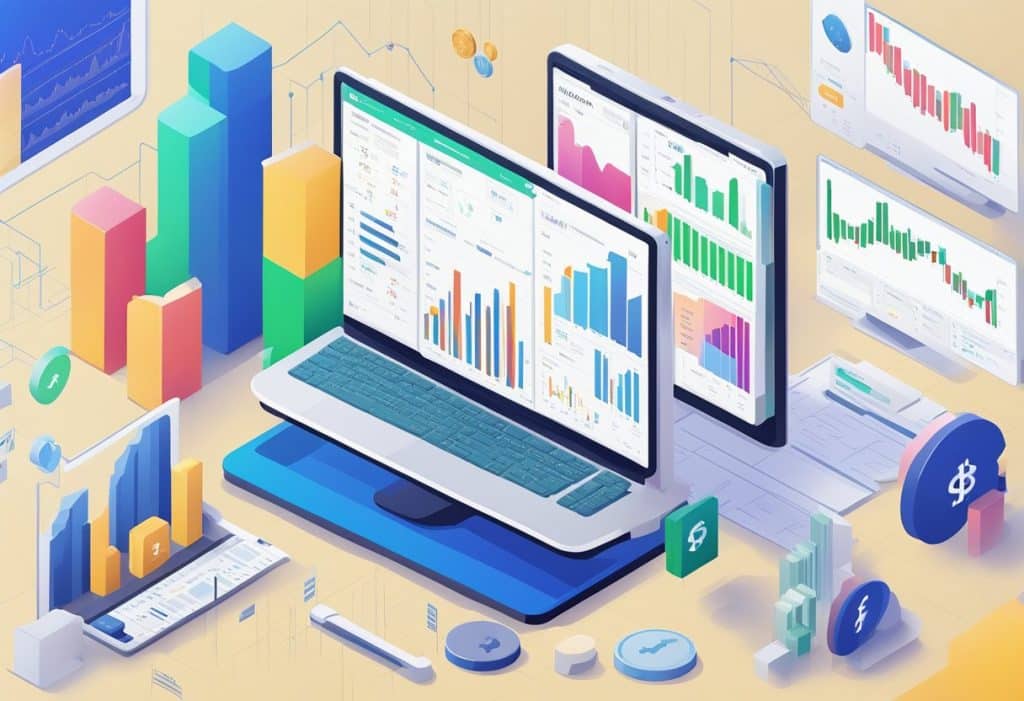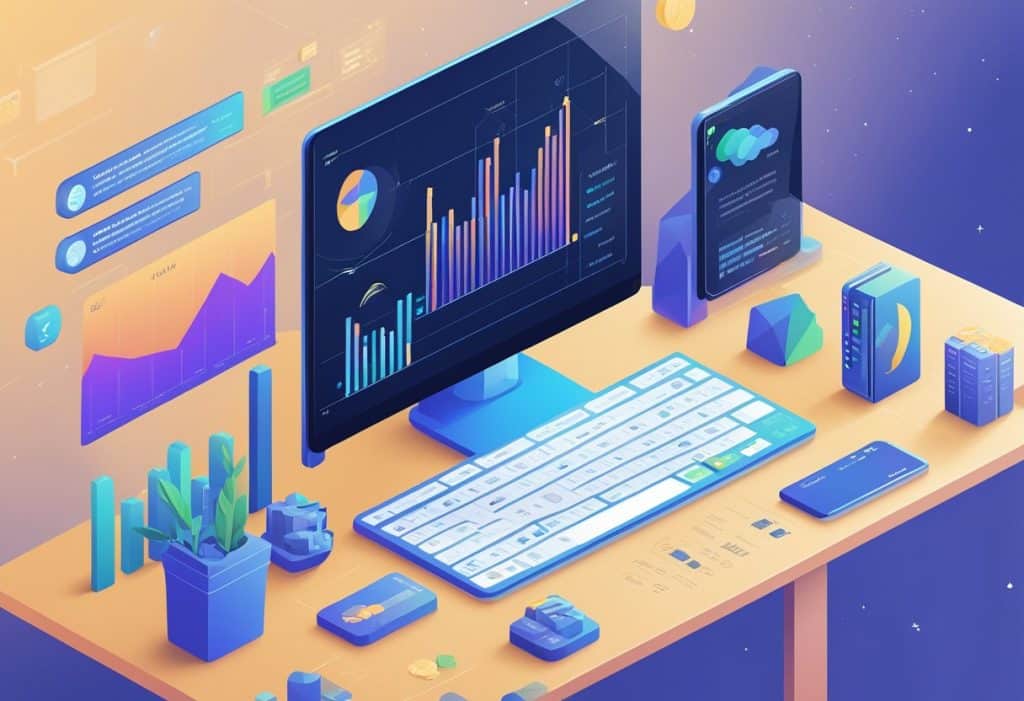Coinbase Futures offers traders the opportunity to engage with the cryptocurrency market through futures contracts. Futures trading allows you to speculate on the future price of cryptocurrencies like Bitcoin and Ethereum without actually owning them. Coinbase, a well-known digital asset exchange, provides a platform for trading these futures. Through Coinbase Advanced, users can access leveraged products, hedge their positions, and diversify their investment portfolios in a regulated environment.

To start trading futures on Coinbase, it’s essential to understand the workings of the market, the types of contracts available, and the margin requirements. Nano Bitcoin futures contracts, for example, are sized at a fraction of the Bitcoin, enabling smaller investors to participate in the futures market with less capital outlay. Trading these contracts is subject to initial margin requirements set by the exchange to maintain the position.
Coinbase Financial Markets (CFM) adheres to strict regulatory oversight to ensure compliance with financial authority standards while offering trading services. By completing the application process, traders can access nano-sized futures contracts, advanced trading tools, and support designed for both novice and experienced individuals looking to engage in the crypto futures market.
Key Takeaways
- Coinbase Futures allows for the trading of Bitcoin and Ethereum contracts with leverage and risk management tools.
- Education and understanding of margin requirements are vital for anyone getting started with Coinbase Futures.
- The platform complies with regulatory bodies, focusing on providing a secure trading environment for its users.
Understanding Coinbase Futures

Coinbase Futures provides a platform for trading contracts tied to the future value of cryptocurrencies, enabling you to leverage potential gains or protect against losses.
What Are Futures?
Futures are financial contracts obligating you to buy or sell an asset at a predetermined future date and price. In the context of cryptocurrencies, these assets typically refer to digital currencies like Bitcoin. The key characteristics of futures include leverage, which allows you to control large amounts of the underlying asset with a relatively small amount of capital.
A futures contract’s value derives from the price movements of the crypto asset it represents. For instance, if you anticipate the price of Bitcoin to rise, purchasing a futures contract could result in profits if the market moves in your favor.
Coinbase Futures Overview
Coinbase Inc offers Coinbase Futures through its platform, allowing you to engage in the trading of futures contracts for various cryptocurrencies. These futures contracts can be traded with leverage, which, when used correctly, can amplify your gains. However, it’s important to understand that leverage can also increase the risk of losses.
Trading Features:
- Leverage: Typically ranging from 1x to 3x, meaning you can trade with up to three times the purchasing power of your balance.
- Contract Size: Contracts represent a fraction of the value of the underlying cryptocurrency, such as a nano Bitcoin futures contract that represents 1/100th of a Bitcoin.
Coinbase Futures provides tools and resources to help you understand the basics of futures trading and leverage, as well as the risks and opportunities associated with it. It’s important to proceed with caution and ensure that you’re well-informed before starting to trade.
Remember, while Coinbase is subject to regulatory oversight and examinations by organizations such as the National Futures Association (NFA), trading futures still carries inherent risks that you should be aware of and prepared to manage.
Getting Started with Coinbase Futures
Coinbase Futures offers a streamlined process for trading futures contracts on cryptocurrencies. Before you begin, you’ll need to understand the process of opening an account and meeting the requirements for futures trading.
Opening a Coinbase Futures Account
To trade futures contracts on Coinbase, you must first open a Coinbase Futures account. Once you have a standard Coinbase account, you can upgrade to access futures trading capabilities. This upgrade often requires additional verification steps to ensure compliance with financial regulations.
Here is how you can start:
- Log in to your existing Coinbase account.
- Navigate to the Futures section on the platform.
- Follow the onboarding process, which may include further identity verification.
Coinbase Futures Account Requirements
Trading futures can be complex and carries a certain level of risk. As a result, there are specific requirements you must meet to participate in Coinbase Futures trading:
- Age: You must be of legal age in your jurisdiction.
- Residency: Make sure that futures trading is permissible in your region, as some areas, including the U.S., may have restrictions.
- Financial Assessment: You may be required to demonstrate financial literacy and the adequacy of financial resources.
Initial Investment Amount for a futures contract is determined by:
- The size of the contract you wish to trade.
- The margin requirements, which is a percentage of the contract’s notional value.
For example:
| Contract Type | Notional Value | Margin Requirement | Initial Margin |
|---|---|---|---|
| Nano Bitcoin (0.01 BTC) | $2,500 | 25% | $625 |
Note: These figures are illustrative and subject to market conditions.
Trading on Coinbase Futures

Coinbase Futures provides you with the platform to trade digital currency futures contracts. Here, you’ll learn how to place trades, understand margin requirements, and explore various futures trading strategies.
Placing Futures Trades
To begin trading on Coinbase Futures, you need to open a CFM Futures Account. When you’re ready to trade, you select the futures contract you wish to buy or sell. If you anticipate the price of Bitcoin will rise, you might buy a contract (go long); if you expect it to fall, you might sell a contract (go short). Spot trading involves trading the immediate delivery of the cryptocurrency. In contrast, futures trading entails the buy or sell of a crypto asset at a predetermined future date and price.
Understanding Margin Requirements
Margin requirements are crucial in futures trading. The initial margin requirement is the percentage of the notional value of the contract that must be available in your account to open a position. For instance, if the initial margin is 25% for a Bitcoin futures contract, and the notional value is $2,500, your initial margin would be calculated as:
| Notional Value | Margin Requirement (%) | Initial Margin Required |
|---|---|---|
| $2,500 | 25% | $625 |
You must maintain the margin requirement for your open positions at all times to avoid liquidation.
Futures Trading Strategies
When trading futures, you can employ strategies like going long or short on a futures contract to hedge against other investments or to profit from anticipated price movements. It’s critical to only trade in financial products that you are familiar with and understand, especially the associated risks. Always consider the leverage involved and ensure it aligns with your risk tolerance and investment objectives.
Regulation and Compliance
As you explore the offerings of Coinbase Futures, it’s essential to understand the framework of regulations and compliances that govern its operations. This backdrop ensures a secure environment for your trading activities.

CFTC and NFA Regulations
Coinbase Futures operates in alignment with the regulations set forth by the Commodity Futures Trading Commission (CFTC) and is registered as a Futures Commission Merchant under the oversight of the National Futures Association (NFA). As an NFA member, Coinbase is subject to NFA’s regulatory oversight, which includes comprehensive examinations to ensure compliance with the highest standards of conduct and practice.
The CFTC, as a federal regulatory agency, grants the necessary approvals for entities like Coinbase to offer futures products. This compliance confirms that the products are appropriately regulated and monitored, providing you with a level of safety and integrity when trading.
Coinbase Compliance
Coinbase has meticulously worked to meet the stringent requirements set by the CFTC and NFA. It operates as a CFTC Registered entity, which involves continuous oversight and routine examinations to verify adherence to regulatory standards. Here are some key compliance points:
- Registered with the CFTC as a Futures Commission Merchant.
- Subject to NFA’s Regulatory Oversight to ensure adherence to the required financial standards and consumer protections.
- Regular reporting to regulatory bodies to maintain transparency and accountability.
Table 1: Coinbase Regulatory and Compliance Overview
| Regulatory Body | Function | Coinbase’s Role |
|---|---|---|
| CFTC | Federal oversight of derivatives market | Futures offering approved |
| NFA | Self-regulatory organization for derivatives industry | Must comply with NFA regulations and standards |
By staying abreast of Coinbase’s commitment to regulation and compliance, you ensure that your trading activities on the platform are within the scope of federal and industry standards.
Risk Management

When trading Coinbase Futures, understanding and managing the inherent risks can significantly influence your overall trading success. This entails both recognizing possible losses and effectively implementing strategies to mitigate such risks.
Understanding the Risks of Loss
Risks from futures trading come from market volatility and leverage. Leverage amplifies both gains and losses, making it crucial to be aware of the margin requirements. These are set by the exchange to ensure there’s enough capital to cover potential losses, calculated as a percentage of the notional value of contracts held.
Coinbase outlines these requirements clearly, but it’s important for you to understand that the market can move against your positions, and such movements can result in a risk of loss that might exceed your initial investment, especially if market conditions are unfavorable or unexpected.
Risk Mitigation Strategies
To mitigate these substantial risks, you should:
- Assess your financial position and only allocate funds that you can afford to lose.
- Carefully evaluate your investment experience and seek additional education if necessary.
- Clearly define your investment objectives to align your strategies with your goals.
Dual strategies like hedging are used to balance potential losses in one investment with gains in another, through derivatives such as options and futures. Moreover, using tools provided by Coinbase, like risk management strategies, can help manage unexpected price movements and enhance your ability to respond to the market effectively.
Risk management is essential to ensure that your futures trading aligns with your financial goals and experience. An informed and strategic approach to managing risk can help protect against significant losses and help you navigate the complexities of leveraged trading.
Market and Financial Instruments

Coinbase Futures provide a platform where you can trade various crypto futures products with a focus on Bitcoin and Ethereum. The innovative financial products offer a way to speculate on the prices of cryptocurrencies without owning the actual digital assets.
Coinbase Futures Products
Bitcoin Futures: At Coinbase Futures, you have the option to trade Bitcoin futures contracts. These contracts are agreements to buy or sell Bitcoin at a predetermined price at a specified future date. Each nano Bitcoin futures contract represents 0.01 of a Bitcoin, allowing for more granular control over your investment.
Ethereum Futures: Like Bitcoin futures, Ethereum futures are also available. These contracts function similarly, providing an agreement to buy or sell Ethereum at a future date for a set price. These futures allow you to hedge current holdings or speculate on future price movements of Ethereum.
Financial Products: The financial products offered are regulated, with the Commodity Futures Trading Commission (CFTC) overseeing the derivatives trading to ensure protection against fraudulent practices. Moreover, Coinbase Financial Markets, which maintains futures accounts, is a member of the National Futures Association (NFA) and adheres to regulatory oversight.
Market Analysis
Analyzing Futures Data: The futures market data can be an indicator of the market sentiment toward the underlying asset. For example, if the Bitcoin futures basis is positive, it might suggest that the market expects the value of Bitcoin to increase.
| Futures Type | Underlying Asset | Notional Value Example |
|---|---|---|
| Nano Bitcoin | BTC | 0.01 BTC per contract |
| Ethereum | ETH | Based on the current ETH market rate |
When you trade crypto futures, you are engaging with the USD value of the cryptocurrency without directly purchasing it. This enables you to participate in the cryptocurrency market while potentially mitigating some of the risks associated with the volatility of the underlying digital assets.
Trading on Coinbase Futures involves understanding both the cryptocurrency market and the specifics of futures contracts. By observing market analysis indicators and utilizing the advanced tools provided, you can make more informed trading decisions regarding when to enter and exit positions.
Technology and Platform
In navigating the Coinbase Futures marketplace, you’ll encounter a robust platform designed for seamless trading as well as a dedicated mobile app for trading on the go, ensuring you’re never out of touch with the markets.
Coinbase Futures Trading Platform
Your trading experience on the Coinbase Futures Trading Platform focuses on efficiency and accessibility. The platform integrates various technologies to facilitate a smooth trading process. For instance, you have APIs that allow for automated trading strategies, giving you the tools to execute trades based on predefined parameters. This is particularly beneficial if you prefer algorithmic trading or simply want to streamline your operations.
The tech infrastructure also supports a variety of order types, ensuring that you can execute strategies that align with your trading goals. The user interface is designed to be intuitive, whether you’re a novice or an experienced trader. Real-time charts, market data, and risk management tools are readily accessible to help you make informed decisions.
Mobile Trading App
When you’re away from your desk, the Coinbase Mobile Trading App ensures that you stay connected to your portfolio. The app provides a comprehensive trading experience, tailored for mobile devices without compromising on features or security.
- Real-time access: Get live price updates and market movements.
- Trade execution: Buy and sell futures contracts with ease.
- Account management: Check your balance, monitor your positions, and adjust your settings.
The technology behind the mobile app ensures that you have a consistent trading experience across all devices. The media and tech industry often highlight the significance of mobile platforms, and Coinbase’s mobile app supports this by offering full functionality similar to the desktop platform.
Remember that while the mobile app is convenient, always ensure you have a secure internet connection to protect your transactions. Maintain software updates for the latest security features provided by Coinbase.
Account Management

Managing your Coinbase Futures account involves understanding the process for deposits and withdrawals, as well as the various fees that can apply to your trading activities.
Deposits and Withdrawals
To start trading futures, you will need to deposit cash into your Coinbase Futures account. The deposit process typically involves moving funds from your Coinbase Inc. (CBI) spot account or a linked bank account. It is essential to ensure your bank information and payment methods are updated to facilitate smooth transactions.
Deposits:
- Funds Transfer: Transfer funds from your Coinbase spot account to your futures account.
- Linked Bank Account: Use a linked bank account as your payment method for deposits.
Withdrawals:
- Cash Balances: Withdraw from your cash balance, which reflects the funds not currently used in open trades.
- Open Trade Equity: Consider your open trade equity, which represents the unrealized gain or loss on your open futures positions.
Understanding Fees
Fees are an integral aspect of trading futures and can impact your overall profitability.
Fee Components:
- Transaction Fees: Charged for executing trades.
- Maintenance Margin: A set amount of capital that must be maintained in your account to keep open positions.
Account Equity:
- Total Equity: Your account balance, which combines your cash balance and any open trade equity.
Example Fee Structure:
| Fee Type | Description |
|---|---|
| Transaction Fees | Charged per trade based on the notional value of the contract. |
| Maintenance Margin Fee | Assessed if the account equity falls below the maintenance margin requirement. |
Remember to review the fee structure as defined by Coinbase Futures to ensure you are aware of the costs associated with your trading activities. Keeping track of these fees is crucial for efficient account management.
Advanced Features
Coinbase Advanced presents a platform for proficient traders seeking to utilize derivatives and complex instruments, such as futures contracts to optimize their trading strategies. These features cater to your need for leveraged positions, allowing for potential heightened returns, albeit with a corresponding increase in risk.
Derivatives and Complex Instruments
Derivatives on Coinbase Advanced, including futures, are sophisticated trading tools that derive their value from underlying assets, such as spot virtual currency products. These instruments allow you to hedge against market volatility, speculate on price movements, and employ leveraged trading strategies. As a participant in these markets, you’re subject to oversight by regulatory entities such as the National Futures Association (NFA), ensuring a level of market integrity and participant protection.
Nano Bitcoin Futures Contract
A Nano Bitcoin futures contract on Coinbase Advanced represents 1/100th of a Bitcoin, offering a lower barrier to entry due to its smaller contract size compared to traditional Bitcoin futures contracts. Here’s a quick look at initiating a leveraged position:
| Action | Notional Value | Initial Margin Requirement |
|---|---|---|
| Buy 10 contracts | 0.01 BTC each at $25,000* | 25% of notional value |
| Sell 3 contracts | – | Adjusted for trade size |
*value for illustrative purposes only
Your initial margin to open this leveraged position would be calculated based on the percentage of the notional value, multiplied by the number of contracts and the leverage applied. This allows for precise control over your investment and opens the potential for magnified outcomes, though it’s crucial to manage the associated risks with care.
Coinbase Ecosystem

Coinbase has established a multifaceted ecosystem that incorporates a robust cryptocurrency exchange with integrated futures trading. This ecosystem is designed to facilitate your engagement with various forms of cryptocurrency transactions, whether you’re interested in spot or futures markets.
Cryptocurrency Exchange Integration
Coinbase operates one of the largest cryptocurrency exchanges globally. When you create a CBi Spot Account, you’re given access to a platform that allows for the trading of numerous cryptocurrencies. The integration of futures trading means you can manage Futures Positions alongside your regular spot trading activities. The use of a unified interface ensures that you can track your portfolio’s performance in real-time.
Initial Margin is a critical component in futures trading; it refers to the upfront payment, expressed as a percentage of the notional value, required to enter into a futures position. For example, if the initial margin rate is 25%, and you’re buying 10 nano Bitcoin futures contracts, each being 0.01 of a Bitcoin with a notional value of $2,500, your initial margin requirement would be calculated as follows:
- Notional Value ($2,500) x Number of Contracts (10) x Bitcoin Fraction (0.01) x Initial Margin Rate (25%) = Initial Margin ($625)
Virtual Currency Exchanges and Custodians
When exploring the Coinbase ecosystem, you’ll encounter Virtual Currency Exchanges and Custodians. These entities play distinct roles:
- Virtual Currency Exchanges like Coinbase provide platforms where you can buy, sell, or trade virtual currencies, often for other digital assets or fiat currencies.
- Custodians, on the other hand, are responsible for the safekeeping of your cryptocurrency assets. They provide security services to guard against theft or loss.
Here is a basic comparison of their roles:
| Type | Function | Example |
|---|---|---|
| Virtual Currency Exchange | Platform for trading | Coinbase Exchange |
| Custodian | Secure storage of assets | Coinbase Custody |
It’s essential to consider both the type of service and the specific provider when managing your cryptocurrency portfolio to ensure your assets are not only active on the markets but also well-protected.
Frequently Asked Questions
When navigating Coinbase Futures, you may have several questions about the trading process, fees, leverage, and eligibility. Below are answers to common queries from users like you.
How can I trade futures on Coinbase?
To trade futures on Coinbase, you must first be registered and approved for futures trading. After gaining access, you can buy and sell futures contracts directly through the Coinbase website or the mobile app using funds from your Coinbase wallet.
Is there a dedicated Coinbase futures trading application?
There is not a separate application exclusively for Coinbase futures trading. Futures trading is integrated into the existing Coinbase platforms, allowing seamless transitions between spot and futures markets.
What are the fees associated with trading Coinbase futures?
The fees for trading futures on Coinbase depend on the specific contract and the volume of transactions. Coinbase typically charges a percentage of the trade’s notional value, and fees may be lower for larger trade volumes.
Can users engage in leveraged trading on Coinbase futures and what are the limits?
Leveraged trading is available on Coinbase futures. The leverage limits depend on the particular contract and regulatory constraints. Leverage can significantly increase both potential gains and the risk of loss.
Are there specific eligibility requirements to participate in Coinbase futures trading?
Yes, to participate in Coinbase futures trading, you are required to meet certain eligibility criteria, which include age and jurisdictional restrictions, and financial suitability standards. Specific verification processes must be completed to gain access.
During what hours is Coinbase futures trading available?
Coinbase futures trading is available 24/7, providing users with the flexibility to trade at any time. This round-the-clock availability aligns with the cryptocurrency market’s continuous operation.
